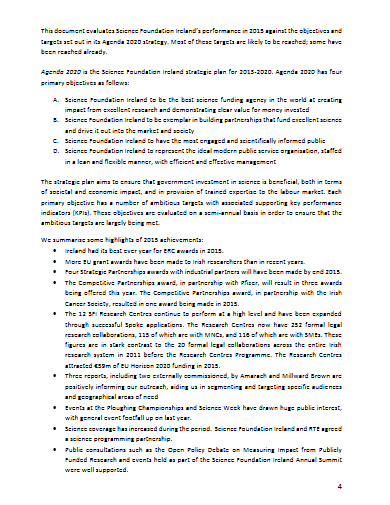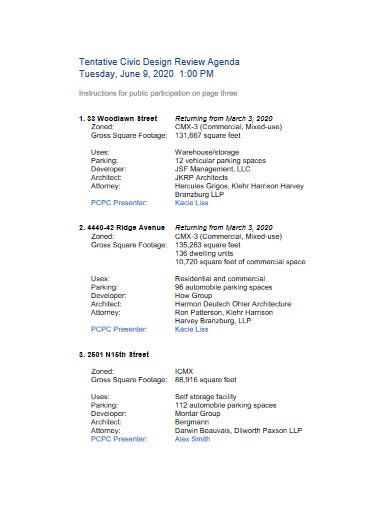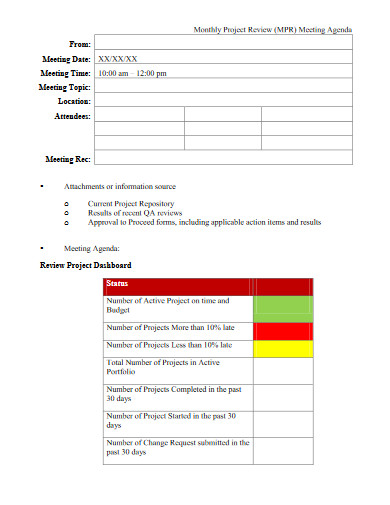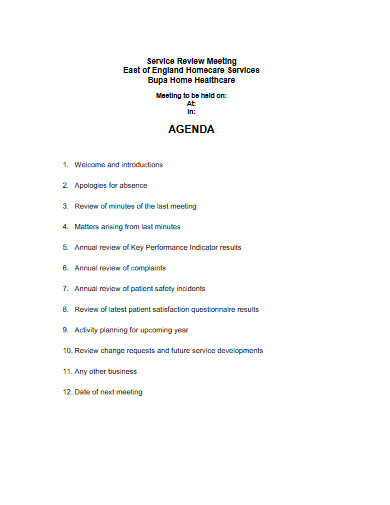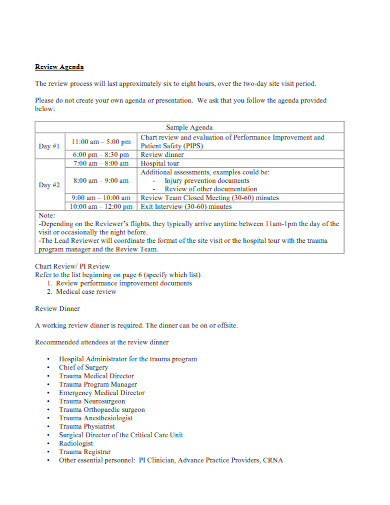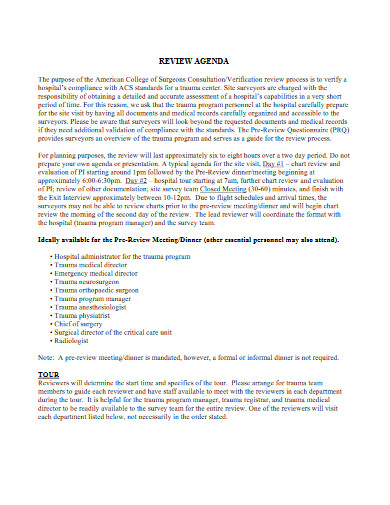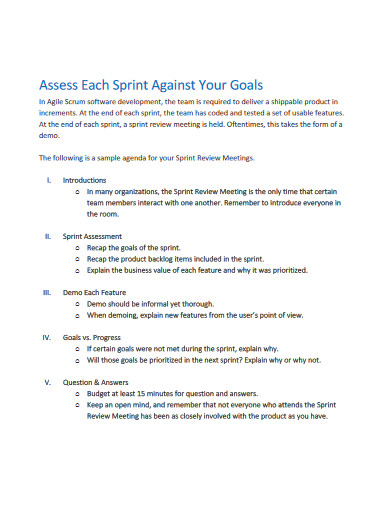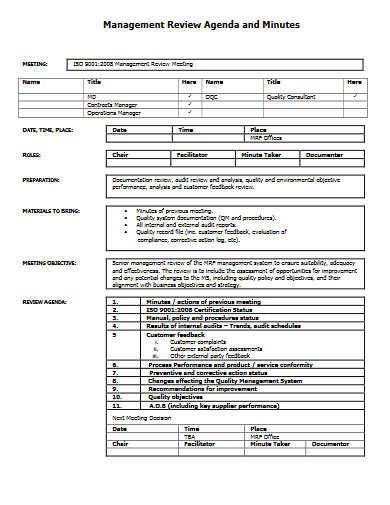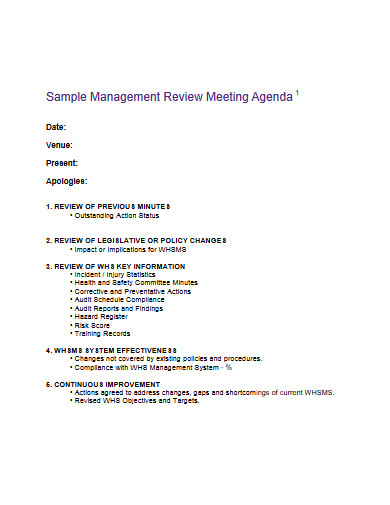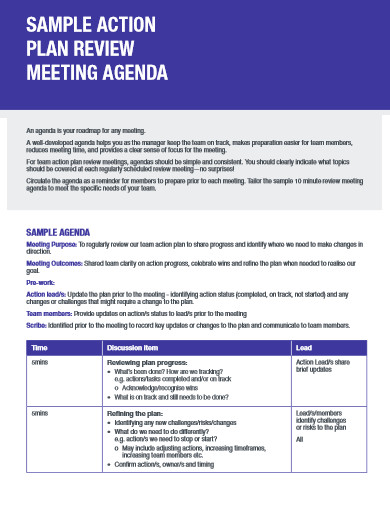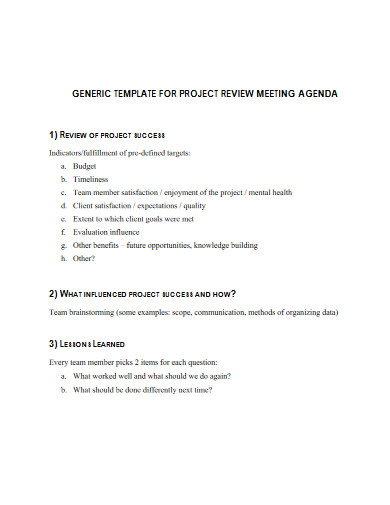10+ Review Agenda Examples to Download
We all have our respective interests and expertise as professionals. However, these wear out if unpracticed for some time. What most business or project management executives do is that they let their subordinates in every department take some time to make analyses, evaluations, or assessments on the quality of their technical performance. Many organizations prefer having these reviews on a monthly basis, while a few choose to have them daily, weekly, quarterly, and annually. It goes without saying that conducting such activities is a good strategy to keep track of an employee’s progress, as well as improve his or her operational performances. So, what are the proceedings in this kind of undertaking? You can find out by taking a look at our examples and article below.
10+ Review Agenda Examples
1. Annual Review of Agenda
2. Design Review Agenda
3. Monthly Project Review Meeting Agenda
4. Service Review Agenda
5. Review Agenda and Logistics Template
6. Committee Review Agenda
7. Review Meeting Agenda
8. Management Review Agenda
9. Sample Management Review Meeting Agenda
10. Action Plan Review Meeting Agenda
11. Project Review Agenda
What Is a Review Agenda?
A review agenda is a thorough list of subjects that will be discussed during a review or refresher session intended for employees or students. Just like other forms of agendas, a review agenda comes with many benefits. In her 2017 article for Calendar, Kayla Sloan accentuated that there are five major benefits that agendas can bring. These include reducing wasting time and resources, allowing the subject speakers to make preparations, promoting the involvement of the meeting attendees; keeping participants on track; and covering the crucial areas of discussion. Because of these factors, it is important to learn how to prepare a review agenda.
The Importance of Reviewing
Students are told to review their notes whenever there are upcoming tests. Just like those students, employees are also encouraged to review some documents on the company’s data inventory before making reports or presenting business matters. The question is – why? For that, we made a list of why reviewing is important for both students and professionals.
1. Reviewing can make any of your composition better. How? Simply because doing so allows you to identify and revise errors that you might not have noticed while writing.
2. Reviewing helps you analyze your work one more time. With that being said, details that you forgot to mention will ring a bell.
3. Reviewing encourages students and professionals to discover ideas, whatever they are working on.
How To Create a Review Agenda
Many executives and teachers find it hard to have in-depth communication with their employees and students. This is because they tend to take a team meeting agenda for granted, or they just don’t know how to create one. Either way, here is our outline of steps and insights to guide you in making one for reviews, and remind you of its advantages.
1. State the Purpose
When making a review agenda, you have to know, first and foremost, the purpose of doing so. Once you’ve clearly determined what your intentions are in setting the agenda, you can already formulate initial ideas of what should be included. You also have to bear in mind that every aspect of a business or studies has different subjects to cover. Because of that, the identification and statement of your review agenda’s purpose have to be done before anything else.
2. List the Subjects To Be Reviewed
It was already established above that each field of studies or business operation has its corresponding coverage that’s distinct from the others. To avoid confusing your target audience, make a list of subjects with respect to your review agenda’s purpose. Aside from that, the list can also prepare the attendants for the topics, such as formulating relevant questions ahead of time or making the necessary tools ready.
3. Set the Date, Time, and Place
Through the constant innovations in our communication means, review meetings can be done almost anywhere. Despite that, traditional face-to-face meetings are still dominant, especially for those with formal talking points. In line with that, setting the date, time, and place or platform is crucial to ensure the perfect attendance of your target audience. Even when setting the meeting on social media, these elements should be made clear to your expected participants in advance.
4. Make Meeting Program
Planned meetings are smoother when compared to those that are unplanned. One factor that contributes to their success is the program. Incorporating a program outline on your agenda helps you with the proper allocation of your review time. By setting a time limit on each of the prepared topics, you encourage every presenter to make their presentations concise. Not only that, but the program also assists you in organizing the listed subject matters in a logical manner.
5. Preliminarily Communicate Agenda
After every component of your agenda has been successfully put in place, you can then make it known to your target audience. There are a lot of ways to do so. One way is through social media, and another is through a memo. Either of the two is effective in making the expected participants aware of the review session.
FAQs:
What is a formal agenda?
A formal agenda is the type of agenda that follows a well-developed format. The format includes the call to order, attendance check, last meeting’s recap, introduction of new issues, presentation of resolutions, and adjournment.
What is the difference between an agenda and a program?
An agenda is a list of multiple programs while a program is a set of activities that are structured to serve a specific purpose.
What are the qualities of a good agenda?
A good agenda should contain everything that the meeting participants have to know about gathering. It should include the following:
1. Goal – description of the agenda’s expectation in terms of the decision, agreement, and resolution
2. Result – the outcome of the agenda
3. Activities – proceedings to obtain expected results
4. Basic Details – fundamental things that participants must know, like date, venue, and time
The act of reviewing is not new to all of us, and all of us are pretty much aware of why it is so important. From students to professionals, such a simple activity provides great benefits to people. To revamp its effectiveness, its proceedings must be thoroughly prepared and organized – things that an agenda can make happen.



